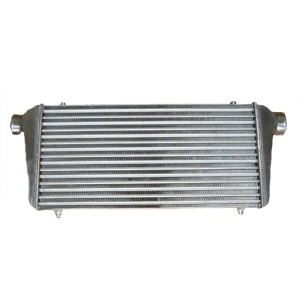News
Racing Radiators Develop With the Normal Car Radiators
The radiator is an indispensable part of a water-cooled internal combustion engine exhaust system. Automotive delta fin intercooler systems generally consist of the water pump, radiator, thermostat, cooling fan, fan motor, electrical switches, wind shield and other components. The temperature is high during the operation, so in order to ensure their normal working performance, the engine must be cooled. The role of the radiator is using cool wind (either formed by the facing flowing wind as the vehicle is running or provided by the cooling fan) to cool engine coolant heated by the high-temperature engine parts.
The car radiator is a composition of thin-wall and high compactness material. Its output value occupies an important position in all parts of a car. The car radiator is manufactured mainly by copper and tin. This is because of the excellent thermal conductivity, corrosion resistance and easy brazing process of the copper. However, due to resource issues and the price of copper, the radiator not only improves in the material thickness, but also has a major breakthrough in the structure. On the basis of the original tube-core structure, the pipe with a wick structure is later invented. This reduces the weight of the car to 70% while the original performance is maintained, which is considered to be the development milestone of radiator industry. This structure is widely used in low-power cars.

The radiator is consisted of radiator wick, upper chamber and button room containing coolant. Because the radiator will produce water vapor during working, the upper chamber also takes the role of separating gas and water. As the wick is arranged vertically, the upper and lower wick are arranged upper and button chambers. Thus the size is rather large so as makes it difficult to be located in the car with lower engine covers. So some wicks are horizontal which have left and right side instead of the so-called cross-flow coolant that uses traditional upper and lower water chamber structure. The width is larger and the effective area increases 10%, thereby increasing the fan size, improve auto exhaust system and getting larger frontal area and making the air more fluent.
As for the car radiators, there will be an improved performance and protection when the radiator is combined with the lubricant. Racing engine lubricants also plays an important role in cooling. Although F1 car has two radiators at both sides in the rear part, the aerodynamicists hope that the radiator can be as small as possible, so that aerodynamic capacity will be better. Engine engineers, however, hope that the radiator becomes bigger. Thus the radiator can cool the engine and coolant more effectively. Lubricants can help balance the two opposite requirements. The racing radiators can cool the engine by the lubricant which flows back and forth between the radiator and engine, making the design of the car more aerodynamic.
When choosing material for the radiator, there are several point needs considering, such as heat transfer performance, corrosion resistance, sufficient strength, good brazing properties, easy processing and molding, and reasonable economy. According to the requirements above, the radiators always take copper and copper alloy as the main material. Holden radiators materials commonly use H90 brass band. Gilled piece radiator adopts H62 or H68 Brass band. The ribbon-tubular radiator often uses T2, or the T3 copper belt. In order to reduce the weight and cost of the radiator, if the strength permitted, the ladder belt allows reaching 0.045mm in width.
With the continuous development of the industrial, the consumption of copper is increasing. For the radiator industry, the material issue is urgent to solve. On the one hand, utilization of material has to be enhanced and the consumption of copper should be reduced. On the other hand, alternative materials such as aluminum, zinc, iron ought to be found. Aluminum Radiator has the feature of light weight, high thermal performance, low raw material costs and reliability. However, due to its complex producing process, large number of producing equipment, and low recycling of the material, even though the price of aluminum radiator is lower than the copper one, the overall price is similar. The aluminum radiator has been widely used in the automobile industry.
In order to improve the cooling performance while reducing raw material costs of the car radiator, some countries in Europe and the United States nowadays launched dual-wave ribbon-tubular radiator. It performs well in the radiator industry. Some factories have introduced the technology and the products have been put on the market. In the near future, structure of this kind will be widely adopted. What's more, the development of auto radiator will accelerate with the improvement in the auto radiators wholesale industry. The performance of the racing car, thus, will gradually enhance.
Related articles:

